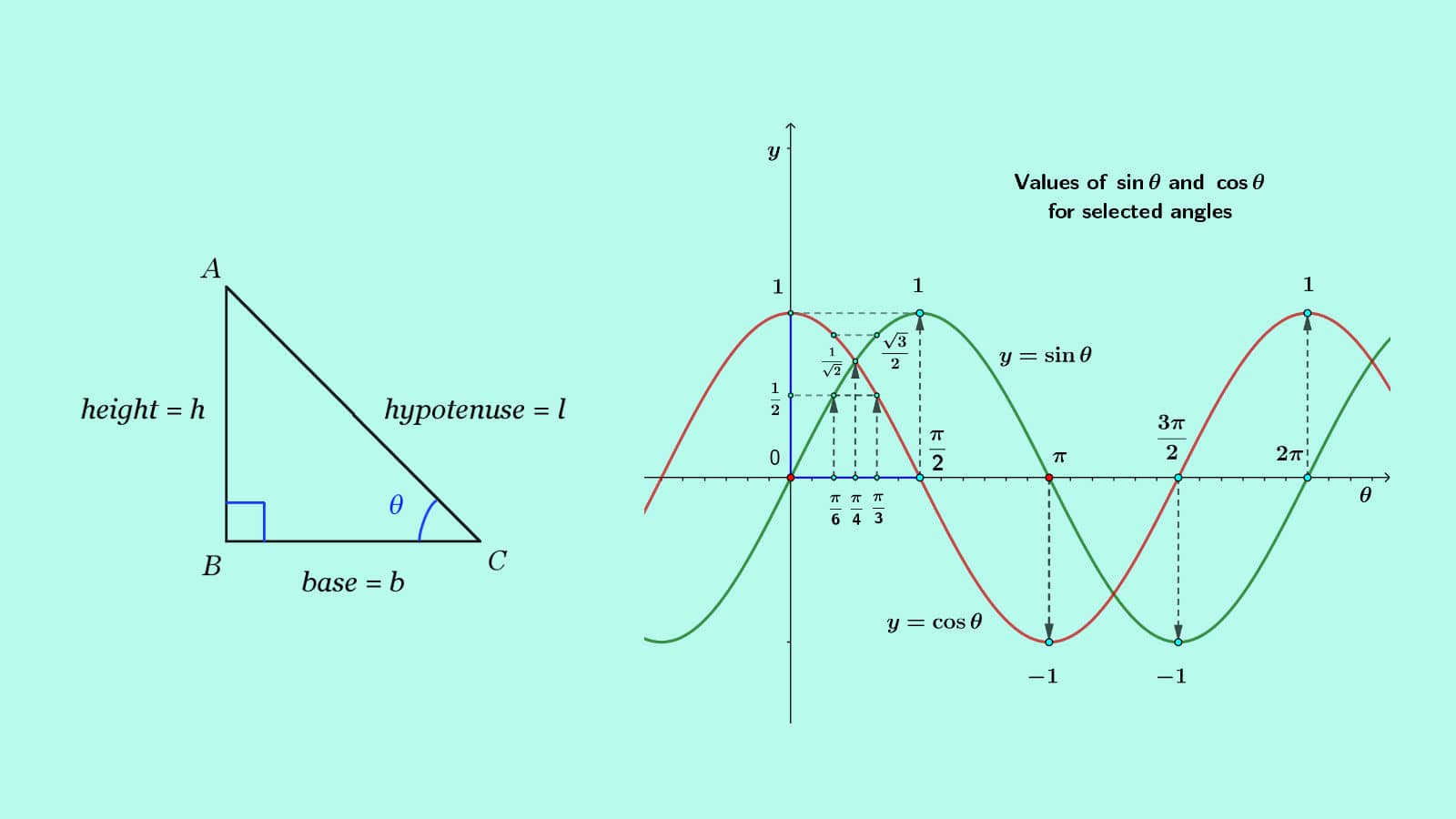
Basic Trigonometry Concepts
Trigonometry concepts: Trigonometry functions, function values, identities, compound angle, multiple angle functions, laws of sine and applications.
The basic trigonometry concepts will be built gradually step by step.
The sections are the following,
- Definition of basic trigonometric functions.
- Values of Trigonometric functions for specific angles - Trigo table.
- Relationships between the basic trigonometric functions - Trigonometric identities.
- Compound angle trigonometric functions.
- Multiple and sub-multiple angle trigonometric functions.
- Law of Sine
- Applications of Trigonometry.
Note: Each of the sections are hyperlinked and clicking on any will take you directly to the section. Return to the previous position by clicking on "Go back" button of the browser at top left corner of the screen.
Definition of basic trigonometric functions
Trigonometry starts by defining its basic trigonometric functions linking an angle with the ratio of a pair of sides of a right-angled triangle. Let us see how.
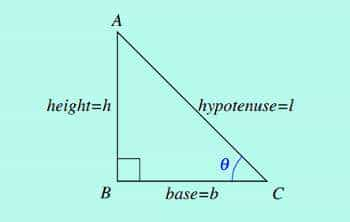
A right-angled triangle as above is the basis of trigonometry.
Important basic elements here are,
- Right angled triangle: $\triangle ABC$ with right angle at $\angle ABC$.
- One of the opposite angles: $\angle {\theta}$.
- Bottom side: $base = b$.
- Perpendicular to the base, $height=h$.
- Diagonal side, $hypotenuse=l$.
The first two trigonometric functions $\sin\theta$ and $\cos\theta$ are defined as ratios of two sides of the right-angled triangle,
$ \sin\theta = \displaystyle\frac{height}{hypotenuse}=\frac{h}{l}$ and,
$\cos\theta = \displaystyle\frac{base}{hypotenuse} = \frac{b}{l} $.
These are the two most basic trigonometric functions from which other four basic trigonometric functions $\tan\theta$, $\sec\theta$, $\text{cosec } \theta$ and $\text{cot }\theta$ are derived,
$\tan\theta = \displaystyle\frac{height}{base} = \frac{h}{b}=\frac{\sin \theta}{\cos \theta} $, it is the ratio of the two primary functions.
$\sec\theta = \displaystyle\frac{hypotenuse}{base} = \frac{l}{b}=\frac{1}{\cos \theta} $, it is just the inverse of $\cos \theta$.
$\\text{cosec }\theta = \displaystyle\frac{hypotenuse}{height} = \frac{l}{h}=\frac{1}{\sin \theta} $, it is just the inverse of $\sin \theta$.
$\text{cot }\theta = \displaystyle\frac{base}{height} = \frac{b}{h}=\frac{1}{\tan \theta} $, it is just the inverse of $\tan \theta$.
Values of Trigonometric functions for specific angles - Trigo table
As each of the basic trigonometric functions is a ratio, for each value of angle $\angle\theta$ each of the trigonometric functions has a specific numerical value. These values have practical utilities, but the whole set of values are not to be memorized by a student. We will see more of which value is to be memorized how.
The first set of values are exhaustive and are to be referred to but not to be memorized by heart. The second set is much smaller and it is a better option for memorization by heart. But in any case, these values can also be quickly evaluated.
Larger set of trigonometric values - Trigo table for all six Trigonometric functions
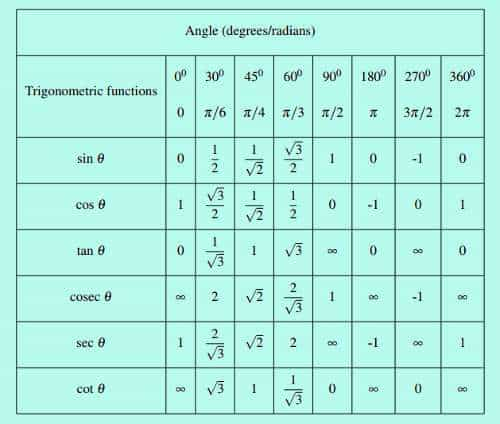
This is a useful list of values of all six trigonometric functions for specific angles that are mostly used.
As $\tan\theta$ and other three functions can be derived from values of $\sin\theta$ and $\cos\theta$ easily, not all these values are needed to be memorized.
If we memorize only the values of $sin\theta$ and $cos\theta$ for specific angles $\theta$, rest of the values can be derived.
Smaller sets of trigonometric values - Trigo table for $\sin \theta$ and $\cos \theta$
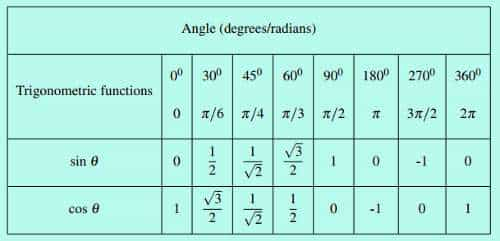
As mentioned above, from this small set of values of $\sin\theta$ and $cos\theta$, values of rest of the four functions can be easily derived.
One of the most distinctive characteristics of the value range of $sin\theta$ and $cos\theta$ is,
Both the functions change from $-1$ to $0$ to $+1$. Absolute value of any of these two can never exceed 1.
Minimum memorization of trigonometric values
Ultimately, if you remember:
Value of $\sin\theta$ increases from $0$ to $1$ for angle $0^0$ to $90^0$, and,
- At $45^0$ values of both $\sin\theta$ and $\cos\theta$ are same and is $\displaystyle\frac{1}{\sqrt{2}}$.
- The values of $\sin\theta$ and $\cos\theta$ for angles $30^0$ and $60^0$ are either of $\displaystyle\frac{1}{2}$ and $\displaystyle\frac{\sqrt{3}}{2}$.
- Finally, $\sin\theta=\displaystyle\frac{1}{2}$ for $\theta=30^0$,
you will be able to derive all other values of the other trigonometric functions.
This approach reduces the memory load and increases accuracy of computation.
Still easier method to memorize values of $sin\theta$
But in spite of this simple situation of memorizing values of $sin\theta$ or $cos\theta$, we still sometimes mixed up the values of $sin30^0$ and $sin60^0$. To get over this slightly confusing situation of memorizing, we have devised a method which is concept based and thus is nearly fail-proof.
If you find it difficult to remember the values of $sin\theta$ and $cos\theta$ for various values of $\theta$, you just have to remember the following picture depicting variation of $sin\theta$ and $cos\theta$ for various values of $\theta$.
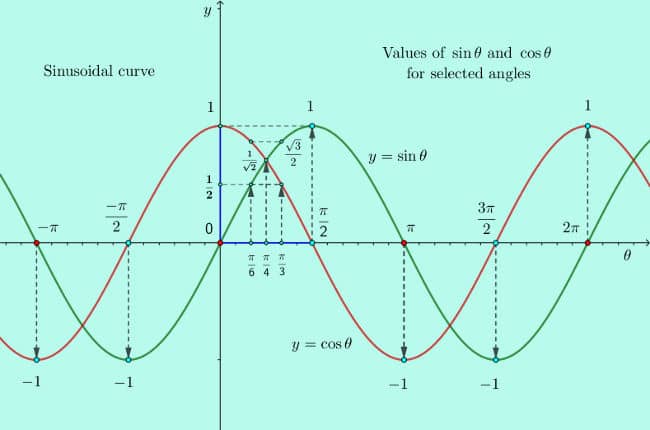
From the figure it can never be forgotten that $cos\theta=1$ when $\theta=0^0$ and its value reduces to $0$ when value of $\theta$ goes on increasing to $90^0$. In between there are two significant values of $cos\theta$, namely $\frac{1}{2}$ and $\frac{\sqrt{3}}{2}$ at $\theta$ values either $30^0$ or $60^0$. As $\frac{1}{2}$ is smaller than $\frac{\sqrt{3}}{2}$, and also as value of $cos\theta$ reduces from 1 to 0, it follows that $cos60^0=\frac{1}{2}$.
This is direct application of the Less facts and more procedure approach or strategy.
Relation between Trigonometric functions - Trigonometric identities
By applying Pythagoras theorem directly, the sum of squares of $\sin \theta$ and $\cos \theta$ results in 1. This is the most basic relationship between two primary trigonometric functions $\sin \theta$ and $\cos \theta$,
$ \sin^2\theta + \cos^2\theta = \left(\displaystyle\frac{h}{l}\right)^2 + \left(\displaystyle\frac{b}{l}\right)^2 = \left(\displaystyle\frac{h^2 + b^2}{l^2}\right)$
Or, $\sin^2\theta + \cos^2\theta = 1 $.
This is the most important and highly used relationship or Trigonometry. This is called a Trigonometric identity.
By this relationship, if one of the $\sin\theta$ or $\cos\theta$ is given the other can be derived by applying Pythagoras theorem.
So, we can say,
Only one of $\sin\theta$ and $\cos\theta$ is the most basic trigonometric function.
By defining these functions,
A definitive measurable relation is established between an angle and the sides of a right triangle.
Other important relations between trigonometric functions or trigonometric identities
Apart from the most important relation between $\sin\theta$ and $\cos\theta$, the other important relations between the trigonometric functions are:
$ sec^2\theta = 1 + \tan^2\theta$, and,
$cosec^2\theta = 1 + \cot^2\theta $.
Also,
$cosec^2\theta + sec^2\theta = cosec^2\theta\sec^2\theta $.
Derivation:
$ sec^2\theta - 1 = \displaystyle\frac{1}{\cos^2\theta} - 1 $
$\hspace{21mm}= \displaystyle\frac{1 - \cos^2\theta}{\cos^2\theta} $
$\hspace{21mm}= \displaystyle\frac{\sin^2\theta}{\cos^2\theta}$
$\hspace{21mm}= \tan^2\theta $
Or, $sec^2\theta = 1 + \tan^2\theta $.
$ cosec^2\theta - 1 = \displaystyle\frac{1}{\sin^2\theta} - 1$
$\hspace{25mm}= \displaystyle\frac{1 - \sin^2\theta}{\sin^2\theta}$
$\hspace{25mm}= \displaystyle\frac{\cos^2\theta}{\sin^2\theta}$
$\hspace{25mm}= \cot^2\theta$
Or, $cosec^2\theta = 1 + \cot^2\theta $.
Also,
$ cosec\theta = \displaystyle\frac{1}{sin\theta}$, and $sec\theta = \displaystyle\frac{1}{cos\theta}$
So, $cosec^2\theta + sec^2\theta = \displaystyle\frac{\cos^2\theta +\sin^2\theta}{\sin^2\theta\cos^2\theta}$
Or, $cosec^2\theta + sec^2\theta = cosec^2\theta\sec^2\theta $.
These three along with the other basic trigonometric function relationships form the base of trigonometric expressions.
Using these building blocks, very complex trigonometric expressions are created.
Value change with change of angle by $\pi/2$ or $\pi$ or by negative sign:
When the angle of $\theta$ is changed by $\pi/2$ or by $\pi$ the values of the trigonometric functions change in simple ways.
Change by $\pi/2$:
$\sin\left(\displaystyle\frac{\pi}{2} - \theta\right) = \cos\theta$, and $\sin\left(\displaystyle\frac{\pi}{2} + \theta\right) = \cos\theta$
$\cos\left(\displaystyle\frac{\pi}{2} - \theta\right) = \sin\theta$, and $\cos\left(\displaystyle\frac{\pi}{2} + \theta\right) = -\sin\theta$.
Change by $\pi$:
$\sin\left({\pi} - \theta\right) = \sin\theta$, and $\sin\left({\pi} + \theta\right) = -\sin\theta$
$\cos\left({\pi} - \theta\right) = -\cos\theta$, and $\cos\left({\pi} + \theta\right) = -\cos\theta$.
Change by sign:
$\sin\left(-{\theta}\right) = -\sin\theta$, and $\cos\left(-{\theta}\right) = \cos\theta$.
Verification from Sin-Cos curve
You can verify all these relationships for change angle, by ${\pi}/2$, $\pi$ or by sign by comparing the actual values from the sin-cos curve above. These relationships follow the sin-cos curve pattern of change of value for change of angle.
Compound angle Trigonometric functions
Till now we have dealt with simple one elementary angle for the trigonometric functions. That is the natural way to start as, finally you can't know the value of a $sin$ function unless you provide the function with one single value.
But the way any subject gets more complex, trigonometry introduces in the same way, relationships between $sin$, $cos$ functions, for even the angle as a sum of two or more different angles.
For example a standard relationship for a compound angle $(A + B)$ is,
$\sin\left(A + B\right) = \sin A\cos B + \cos A\sin B$ ..........(F1)
By replacing $B$ with $-B$ you can always get,
$\sin\left(A - B\right) = \sin A\cos B - \cos A\sin B$
For $cos$ function the following identity for compound sum angle holds,
$\cos\left(A + B\right) = \cos A\cos B - \sin A\sin B$ .............(F2)
Replacing $B$ again by $-B$ you would get,
$\cos\left(A - B\right) = \cos A \cos B + \sin A \sin B$.
Using the expressions of $\sin\left(A + B\right)$ and $\cos\left(A + B\right)$, the following compound angle relation for $\tan\left(A+B\right)$ can easily be derived.
$\tan\left(A+B\right)=\displaystyle\frac{\tan A+\tan B}{1-\tan A.{\tan B}}$.
For detailed proof of compound angle relations you may refer to Basic and rich Trigonometry concepts part 2, proof of compound angle relations.
Rich concept - further derivation from compound angles
Adding the two $sin$ relationships for compound angles you will get,
$\sin(A + B) + \sin(A - B) = 2\sin A \cos B$, the $\cos A \sin B$s cancel out.
Or, $2\sin A \cos B = \sin(A + B) + \sin(A - B)$. ........(F3)
Similarly adding two $cos$ compound angle relationships you would get,
$2\cos A \cos B = \cos\left(A + B\right) + \cos\left(A - B\right)$ .........(F4)
Derived formula by subtraction of two $sin$ compound angle relationships
By subtraction from two $sin$ compound angle relationships,
$2\cos A\sin B = \sin\left(A + B\right) - \sin\left(A - B\right)$ ............(F5)
Derived formula by subtraction from two $cos$ compound angle relationships
$2\sin A\sin B = \cos\left(A - B\right) - \cos\left(A + B\right)$ ..............(F6)
Multiple angle Sub-multiple angle Trigonometric functions
Sub-multiple angle Trigonometric functions
Sub-multiple angle means fraction of an angle. For example angle $\displaystyle\frac{A}{2}$ is a sub-multiple angle for angle $A$. We are now onto derivation of formulas involving sub-multiple angles.
With the arsenal of formulas that we have developed by now it is easy to go into sub-muliples. Let us see how.
Formula involving sub-multiple angle derived from formula $F3$
In formula $F3$ if you substitute $\displaystyle\frac{A + B}{2}$ for $A$ and $\displaystyle\frac{A - B}{2}$ for $B$, you will get,
$\sin A + \sin B = 2\sin\left(\displaystyle\frac{A + B}{2}\right)\cos\left(\displaystyle\frac{A - B}{2}\right)$
Formula involving sub-multiple angle derived from formula $F4$
In formula $F4$ if you substitute $\displaystyle\frac{A + B}{2}$ for $A$ and $\displaystyle\frac{A - B}{2}$ for $B$, you will get,
$\cos A + \cos B = 2\cos\left(\displaystyle\frac{A + B}{2}\right)\cos\left(\displaystyle\frac{A - B}{2}\right)$
Formula involving sub-multiple angle derived from formula $F5$
In formula $F5$ if you substitute $\displaystyle\frac{A + B}{2}$ for $A$ and $\displaystyle\frac{A - B}{2}$ for $B$, you will get,
$\sin A - \sin B = 2\cos\left(\displaystyle\frac{A + B}{2}\right)\sin\left(\displaystyle\frac{A - B}{2}\right)$
Formula involving sub-multiple angle derived from formula $F6$
In formula $F6$ if you substitute $\displaystyle\frac{A + B}{2}$ for $A$ and $\displaystyle\frac{A - B}{2}$ for $B$, you will get,
$\cos A - \cos B = 2\sin\left(\displaystyle\frac{A + B}{2}\right)\sin\left(\displaystyle\frac{B - A}{2}\right)$, alert: beware of the sign change.
Derived multiple angles - 2A - substitute $A$ for $B$
$\sin 2A = 2\sin A\cos A$
$\cos 2A = \cos^2 A - \sin^2 A$
Derived multiple angles - 3A - substitute $2A$ for $B$
$\sin(A + 2A) = \sin A\cos 2A + \cos A\sin 2A$
Or, $\sin 3A = \sin A(\cos^2 A - \sin^2 A) + \cos A(2\sin A\cos A)$
$=3\sin A\cos^2A - \sin^3 A$
$=3\sin A(1 - \sin^2A) - \sin^3 A$.
So, finally,
$\sin 3A = 3\sin A - 4\sin^3 A$.
Similarly,
$\cos 3A = 4\cos^3 A - 3\cos A$.
This way you can derive any multiple or sub-multiples.
An example of half-angle,
$ \sin A = 2\sin \displaystyle\frac{A}{2}\cos \displaystyle\frac{A}{2} $.
To add further complexity levels, you can consider changes in sub-multiples or multiples in the same way as the original singular angles.
For all compound angle, sub-multiple angle and multiple angle relationships then the basic relationships are only,
- Three sets of change of angle relationships that you can derive from the $sin-cos$ curve,
- One compound angle $sin$ relationship $F1$, and
- One compound angle $cos$ relationship $F2$.
Law of Sine
In a triangle $\triangle ABC$ with three sides as $BC=a$, $AC=b$, $AB=c$ and three angles $\angle A = \angle BAC$, $\angle B = \angle ABC$ and $\angle C = \angle ACB$, according to the Sine law,
$ \displaystyle\frac{\sin A}{A} = \displaystyle\frac{\sin B}{B} = \displaystyle\frac{\sin C}{C} = \text{Constant} $
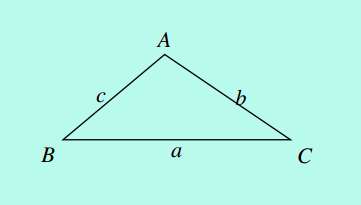
Application of Trigonometry - heights and distances
In this problem area, an object stands upright perpendicularly on the surface and from a distance the object is observed. If the angle of elevation is known along with one of the height or distance to the object, the other can be known.
This is one of the important application areas of Trigonometry.
Angle of elevation
When the observer looks up to the top of a tall object, the angle made by the horizontal line through point of observation and the line from the top of the object to the point of observation is the angle of elevation.
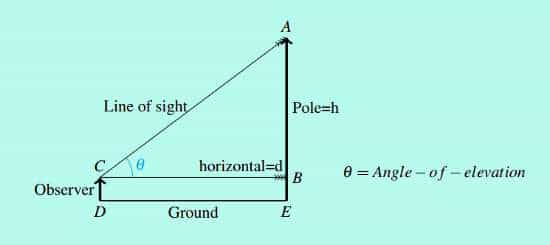
We have here, $\displaystyle\frac{h}{d}=\tan\theta$.
Angle of depression
When an observer looks down from the top of a tall object, we get angle of depression.
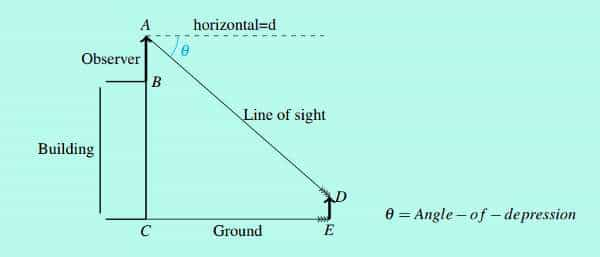
Problem example 1:
From a point $A$ on the bridge over a river, the angles of depression of the banks on the opposite sides of the river are $30^0$ and $45^0$ respectively. If the bridge is at a height of 9m above the river surface, find how wide is the river.
Width of the river is $DC$. In triangle $\triangle ABC$, $\tan 30^0=\displaystyle\frac{AB}{BC}$.
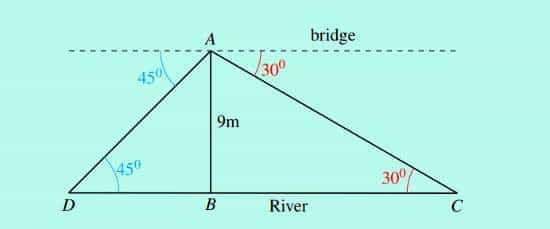
So, $BC=\displaystyle\frac{9}{\tan 30^0} = 9\sqrt{3} m$.
In $\triangle ABD$,
$\tan 45^0 = \displaystyle\frac{AB}{BD}$
$AB = BD$
$BD = 9m$
$DC = DB + BC = 9 + 9\sqrt{3} = 9(\sqrt{3} + 1)=24.588m$.
Guided help on Trigonometry in Suresolv
To get the best results out of the extensive range of articles of tutorials, questions and solutions on Trigonometry in Suresolv, follow the guide,
The guide list of articles is up-to-date.
